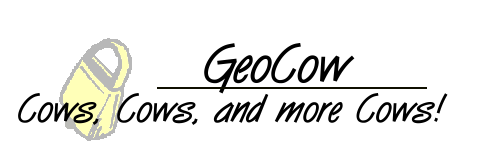
























Since 02/03/00

Did you know:
* An average 1,000 lb steer produces about 430 lbs of beef
* About 77% of all American restaurants have hamburgers on the menu
* People on every continent raise cattle
* There are more cows than people in Australia, New Zealand, Brazil, and Ireland
* The word "daughter" corresponds to the Greek word "thaughter," or "the milker"
* An average American consumes 65 lbs of beef each year
Each day the dairy cow can produce up to:
-
64 qts milk (256 glasses) or,
14 lbs cheese or,
5 gal ice cream or,
6 lbs butter
Milestones of Milk History in the U.S.
-
1611 Cows arrive for Jamestown Colony
1624 Cows reach Plymouth Colony
1841 First regular shipment of milk by rail
1856 Pasteur experiments start
1856 Gail Borden rec'd first patent on condensed milk
1857 First successful condensery built by Gail Borden
1878 Continuous centrifugal cream separator invented by Dr. Gustov De Laval
1884 Milk bottle invented by Dr. Harvey Thatcher, Potsdam, NY
1886 Automatic bottle filler & capper patented
1890 TB testing of dairy herds introduced
1890 Babcock perfected test for fat content of milk/cream
1892 Certified milk originated by Dr. Henry Coit
1895 First commercial pasteurizing machines introduced
1908 First compulsory pasteurization law (Chicago)
1911 Automatic rotary bottle filler & capper perfected
1914 Tank trucks first used for transporting milk
1919 Homogenized milk sold successfully in Torrington, Conn.
1932 Ways of increasing Vit. D in milk made practicable
1938 First farm bulk tanks for milk began to replace cans
1942 Every-other-day milk deliver started as a conservation measure
1946 Vacuum pasteurization method perfected
1948 UHT pasteurization introduced
1948 First plastic coated paper milk cartons introduced commercially
1964 Plastic milk container introduced commercially
1974 Nutrition labeling of fluid milk products
Cows are not indigenous to America. Columbus brought cattle with him on
his second voyage to the New World. Due to the high loss of human life
when the pilgrams made their voyages, it became English law that each
ship destined for the new world had to carry one cow for each five
passengers. The ships's captain would then sell the cattle and that
would bring the captain a little income. However, this practice also
introduced disease into our population. In 1843, a New Yorker by the
name of Peter Dunn purchased a cow from a sea captain. The cow was
incubating the disease called Contagious Bovine Pleuropneumonia (CBPP).
That cow infected others and resulted in huge livestocklosses in three
major epidemics over a 40 year period. In fact, the sole reason the USDA
was formed (called the Bureau of Animal Industry or BAI at that time) was
to combat and eradicate CBPP.
Jokes | Puzzles | Updates | WebRings